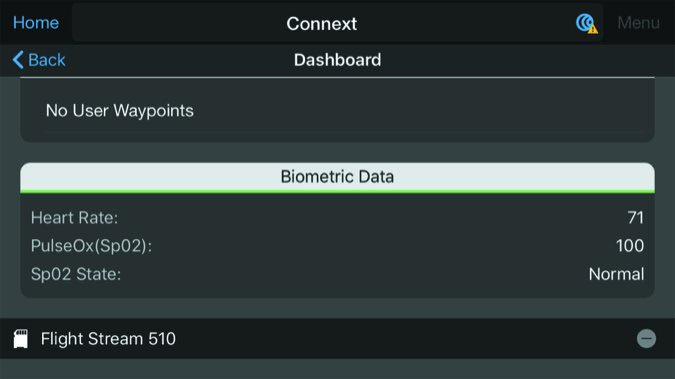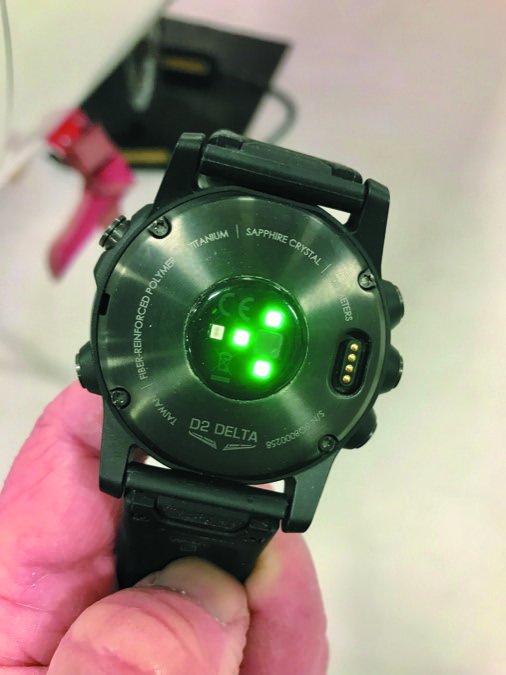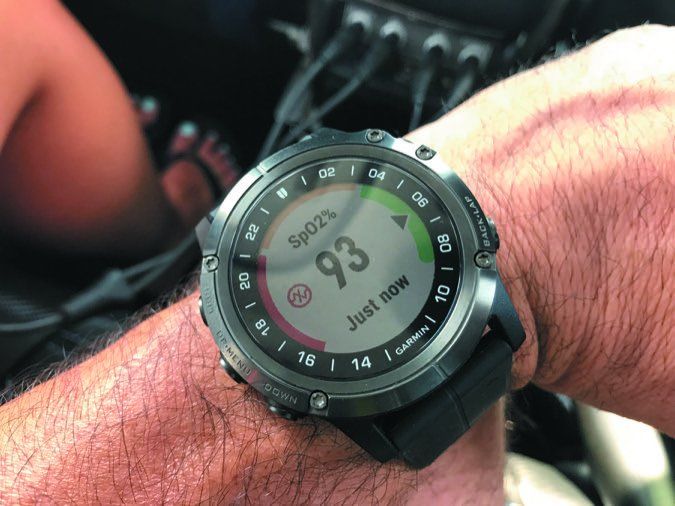Compared to other portable gadgets, cockpit health monitors have been surprisingly slow to evolve. As an aging athlete, I obsess about heart rate, pulse and hydration, and add blood oxygen saturation to that list in the airplane.
Other athletic pilots agree that it sure would be convenient if there was one device that did it all, and since we covered pulse oximeters in the September 2017 issue of Aviation Consumer, Garmin released the D2 Delta PX aviator watch. It has an integrated pulse oximeter and a variety of other biometrics capabilities. I’ve been using it for close to a year and found that while it’s not the perfect solution, it comes close, with limitations.
Premium Priced
When we last rounded up pulse oximeters we uncovered some favorites, which included high-end models like the Masimo MightySat and Nonin 9950, but still concluded that plain-vanilla entry-level monitors get the job done. Moreover, some later models of the Samsung Galaxy smartphones have a pulse oximeter function, and in general users report favorable results.
But combining pulse oximetry into the already rich user feature set of Garmin’s latest aviator watch seems like a logical step up in utility. Having evaluated all of Garmin’s earlier aviator watches, it’s a feature I’ve always thought was missing, until now. But you’ll have to dig deep into the wallet to get it.
The pulse oximeter is only available on the $1249 flagship D2 Delta PX watch and not the standard D2 Delta and Delta S models. The Delta PX also has heart rate monitoring, which is sourced via the sensor on the underside of the watch. The watch also connects with Garmin’s chest heart rate sensors. More on this interface in a minute.
The Delta PX includes the SPO2 function as a widget and like other widgets in the feature set you access it with the lower left (Down) widget loop mode button on the watch face. The widget shows SPO2 as an elevation profile so you can monitor how the reading is changing relative to the altitude. There’s also a color-coded awareness graph mode, displaying red, yellow and green (green is safe, red is not and yellow is marginal), along with a numeric readout of percentage of SPO2. There’s also a graph summarizing samples from the last 24 hours.
Wrist-Based Limitations
The first time you use the pulse oximeter widget the watch must have a valid GPS fix (it has a built-in GPS receiver) to determine elevation. During flight, the watch automatically takes pulse oximeter readings more frequently. The data is sent (via Garmin’s Connext Bluetooth interface) to the biometrics data field on the Garmin Pilot smartphone app’s dashboard.

Obviously, the watch samples SPO2 data at the wrist and several clinicians I talked with said that the fingertip (followed by the earlobe) offers the most accurate measurement of the saturation of oxygen in the blood. To review the basics, a typical finger-based pulse oximeter shines two beams of light through the finger-one beam is red and the other is invisible infrared. The two beams enable the instrument to detect the changes in color of the arterial blood caused by the heart pushing arterial blood into the finger. And there’s the potential limitation of a wrist-based pulse oximeter.
Since the change in arterial blood color is so small, a pulse oximeter works best when measuring in an area of a strong pulse signal, such as the fingertip. If the signal is too weak, readings might be skewed, or no reading may occur at all. This limitation was obvious when using the Delta PX’s sensor. The manual warns that you must remain stationary for up to 30 seconds for the watch to obtain a sample and I found that challenging in flight. Even slight movements of the wrist were obviously hindering the device’s ability to offer an immediate reading, or at least match the sampling speed of a traditional finger-based pulse oximeter.
As for accuracy, I compared the Delta PX to my Masimo MightySat pulse oximeter. Sometimes the two devices provided identical readings, and other times the spread was as much as 4 percent. Garmin offers caveats saying in part that its wearables aren’t medical devices and the displayed data is not intended to be utilized for medical purposes.
Garmin’s legal statement says that the Delta PX’s pulse ox function simply provides an estimation of the user’s SPO2 percentage. The fit of the watch on the wrist, the user’s physical characteristics and the presence of ambient light may impact the device’s readings. Garmin goes on to say that it may release device software over time to improve aspects of the measurements.
If you struggle with readings, the manual offers tips for erratic pulse oximeter data. This includes wearing the watch above the wrist bone-snug, but comfortable. You can also try holding the arm wearing the watch at heart level while it takes a sample. I use the watch with the silicon sport band (the PX comes with a leather band as standard) and the manual lists the sport band as something to try for better readings. You should also wash and dry the wrist (and the watch’s optical sensor) before every use and ensure there isn’t sunscreen or lotion on the skin below the sensor.

Plenty Of Functionality For Athletes
At $1249, I don’t think many pilots will be rushing out to buy the D2 Delta PX for its pulse oximeter function alone, but the feature nicely complements the device’s aviation functions (we’re covering the entire feature set in an upcoming comparison of cockpit wearables, including Apple’s Watch).
But if you’re an athlete and a pilot, the Delta PX offers sizable utility. During my trials, I used the Delta PX as an integral instrument for cycling training. This includes connecting the device to Garmin’s chest-strap heart rate sensor and a new Edge cycling computer.
Like the pulse oximeter, the wrist-based heart rate sensor has limitations and I noted a typical spread of 5 BPM (beats per minute) when comparing the integral sensor with the chest strap. There’s also a slight lag in displaying changes in HR.
But for pilot cardio patients who want to monitor pulse and heart rate as doctors I spoke with suggest they do, the D2 Delta PX gets it done.
Last, there are no FAA regulations that I can find governing the use of pulse oximeters, which makes the Delta PX fair game as a primary pulse ox as long as you absolutely understand and accept its limitations, just as Garmin suggests.





